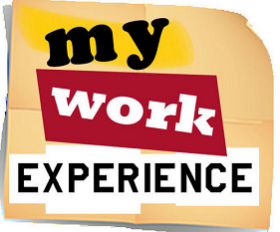 The content of your resume will take the most time to get right. But it is time well spent. Work History, Work Experience, Professional Experience – whatever you call it, it is the most important part of your resume, so spend the time to get it right.
The content of your resume will take the most time to get right. But it is time well spent. Work History, Work Experience, Professional Experience – whatever you call it, it is the most important part of your resume, so spend the time to get it right.
There are a few basic things that you must include:
- the name of the company,
- the city and state where you worked,
- the title/position you held (in instances where you were promoted, only list the last one), and,
- the beginning and ending dates of employment (written as Month/Date – Month/Date) for each job/place of employment that you are including.
Full-time, part-time, self-employment, work study or internships, contract positions – all of these can and should be included in this section. Volunteer jobs or other unpaid charitable work should not. If you have experience of this type that you think is relevant you can put it in a Relevant or Other Experience section.
The trickier part is how to present your actual experience. Your resume should only be one page (maybe two, if you have a lot of experience or are applying for a senior position), so you need to get across the most relevant information in the most effective and succinct way possible. Use an active, not passive voice, and don’t be vague or too general.
Don’t make the mistake of thinking your job description or a list of responsibilities will do the job. It won’t. It’s boring to read and gives no details or important information that someone can truly evaluate your suitability on.
Click here to send us your resume. Our placement service is always free for job seekers.
One reliable way to develop good content is to use the PAR approach – Problem, Action, Result – to develop bullet points that present your experience in a meaningful way that hiring managers will notice and respond to.
So, how do you do it?
First think about a problem that occurred at work. What action did you take and what was the result?
For example:
Problem: Sitting down and completing the paperwork for the on-boarding process was consistently given a poor rating by new hires.
Action: After much research, I moved the process online allowing new hires to complete and submit the paperwork on their own time.
Result: This not only improved the rating by new hires but also improved the accuracy of the paperwork.
Now you have the details to develop a great bullet point that could read something like this:
Optimized the onboarding process by moving the paperwork online and implementing e-signature capabilities. This reduced errors to almost zero and increased the survey rating of the process.
Continue to think of problems that you helped solve to develop other bullet points. It doesn’t have to be a problem necessarily either. Focus on any actions that resulted in tangible results. Look at your current resume and see if there are things that you can improve. For example:
Basic: Managed team and project successfully on time and on budget.
Better: Managed matrix team (3 Business and 2 QA Analysts, 4 Developers, 2 Project Coordinators, etc.) on an enterprise loan application project from beginning-to-end. Project completed under budget ($4.5MM vs. $5MM) and ahead of projected deadline (22 vs. 24 months).
Basic: Developed and improved website traffic by bettering the site efficiency and SEO.
Better: Lead improvement of web development project utilizing (HTML, CSS, JavaScript); developed site with a more modern, clean overall layout, and worked to enhance the SEO – this lead to 37% increase in web traffic in the 1st quarter.
You want to quantify your results as much as possible and add data or other measurements or KPIs to make your statements more meaningful and helpful to the reviewer. Anyone can say they “managed” projects or “improved” something, but how? And by how much? What did you actually do to improve things? Did you improve efficiency? Sales? Customer Service? Production time? Did you reduce errors or downtime? These kinds of details are what hiring managers will notice. It gives them something consequential to evaluate instead of just overused platitudes and vague phrases.
Potential employers want to know that you can do the job, perform the work they need done, and help them address their specific problems and projects. Tailor your content to the particular job you are applying for and give examples of things you accomplished at past companies that match their needs and requirements. Show them you’ve done it before and done it successfully.
Develop multiple bullet points for each of your previous positions, more than you need even, and choose the ones that make sense to include based on what you are applying for. Sometimes you may decide to develop something entirely new, but often you may find you can swap out examples of your work that stress your project management experience more than your development skills, or show your familiarity with one system or software over another. This will allow you to tailor each resume without spending too much time.
This section is the most important part of your resume, therefore it is critically important that you spend the most time and effort on it. Create the best examples of your experience. Give the facts and figures that matter and make sure every word counts. It could be the difference between getting the job, or not!
Looking for a new job? Read: How to Optimize Your Job Search, A Comprehensive Guide for Every Job Seeker

Leave a Reply